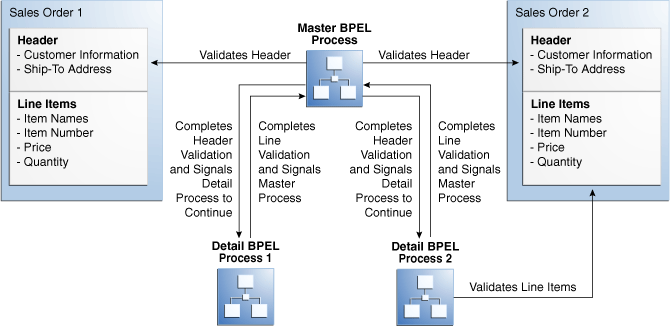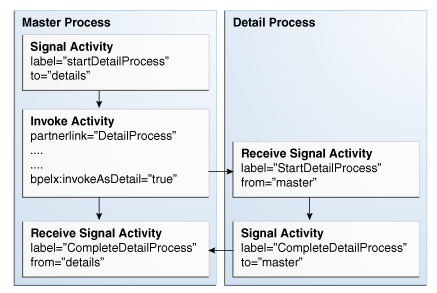Introduction to Master and Detail Process Coordinations
Master and detail coordinations consist of a one-to-many relationship between a single master process and multiple detail processes.
For example, assume a business process imports sales orders into an application. Each sales order consists of a header (customer information, ship-to address, and so on) and multiple lines (item name, item number, item quantity, price, and so on).
The following tasks are performed to execute the order:
-
Validate the header. If the header is invalid, processing stops.
-
Validate each line. If any lines are invalid, they are marked as invalid and processing stops.
-
Perform inventory checks for each item. If an item is not available, a work order is created to assemble it.
-
Stage items at the shipping dock after items for each line are available.
-
Ship the order to the customer.
To perform these tasks, create a master process to check and validate each header and multiple BPEL processes to check and validate each line item.
Potential coordination points are as follows:
-
The master process must signal the detail processes that header validation is successful and to continue processing.
-
Each detail process must signal the master process after line item validation is complete.
-
Each detail process must signal the master process after the line item is available in inventory.
-
After all line items are available, the master must signal each detail process to move its line item to the shipping dock (the dock may become too crowded if items are simply moved as soon as they are available).
-
After all lines have been moved, the master process must execute logic to ship the fulfilled order to the customer.
Figure 16-1 provides an overview of the header and line item validation coordination points between one master process and two detail processes.
Figure 16-1 Master and Detail Coordination Overview (One BPEL Process to Two Detail Processes)

Description of "Figure 16-1 Master and Detail Coordination Overview (One BPEL Process to Two Detail Processes)"
The following BPEL process activities coordinate actions between the master and detail processes:
-
Signal: notifies the other processes (master or detail) to continue processing
-
Receive signal: waits until it receives the proper notification signal from the other process (master or detail) before continuing its processing
Both activities are coordinated with label attributes defined in the BPEL process files. Labels are declared per master process definition.
Figure 16-2 provides an overview of the BPEL process flow coordination.
Figure 16-2 Master and Detail Syntax Overview (One BPEL Process to One Detail Process)

Description of "Figure 16-2 Master and Detail Syntax Overview (One BPEL Process to One Detail Process)"
As shown in Figure 16-2, each master and detail process includes a signal and receive signal activity. Table 16-1 describes activity responsibilities based on the type of process in which they are defined.
Table 16-1 Master and Detail Process Coordination Responsibilities
| If A... | Contains A... | Then... |
|---|---|---|
|
Master process |
Signal activity |
The master process signals all of its associated detail processes at runtime. |
|
Detail process |
Receive signal activity |
The detail process waits until it receives the signal executed by its master process. |
|
Detail process |
Signal activity |
The detail process signals its associated master process at runtime that processing is complete. |
|
Master process |
Receive signal activity |
The master process waits until it receives the signal executed by all of its detail processes. |
If the signal activity executes before the receive signal activity, the state set by the signal activity is persisted and still effective for a later receive signal activity to read.